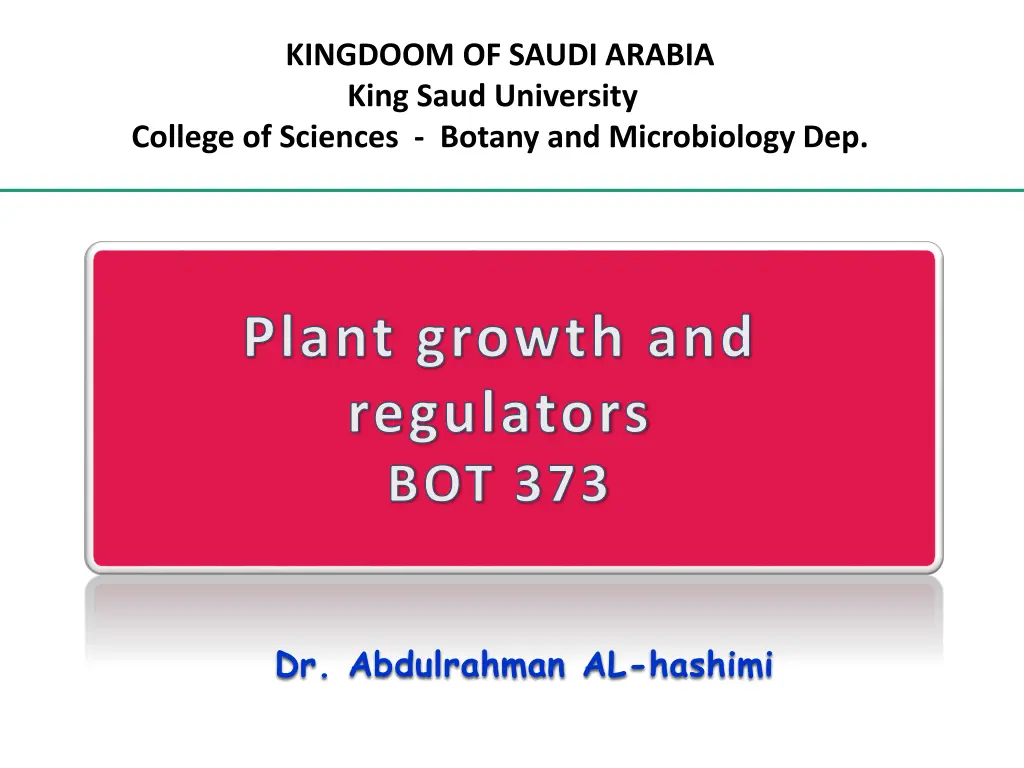
Understanding Apical Dominance in Plant Growth and Regulation
Explore the concept of apical dominance in plants, where the terminal bud inhibits the growth of lateral buds. Discover how pruning can control the shape of trees, stimulating lateral bud growth and branching. Learn about the nutritional and hormonal explanations behind apical dominance and its implications in plant development.
Download Presentation

Please find below an Image/Link to download the presentation.
The content on the website is provided AS IS for your information and personal use only. It may not be sold, licensed, or shared on other websites without obtaining consent from the author. If you encounter any issues during the download, it is possible that the publisher has removed the file from their server.
You are allowed to download the files provided on this website for personal or commercial use, subject to the condition that they are used lawfully. All files are the property of their respective owners.
The content on the website is provided AS IS for your information and personal use only. It may not be sold, licensed, or shared on other websites without obtaining consent from the author.
E N D
Presentation Transcript
KINGDOOM OF SAUDI ARABIA King Saud University College of Sciences - Botany and Microbiology Dep. Plant growth and regulators BOT 373 Dr. Abdulrahman AL-hashimi
Lecture 5 The role of auxin in apical dominance
Buds are generally an embryonic green group consisting of a small stem bearing a group of leaves in an embryonic form. The terminal bud arises from an apical meristem, while the axillary (lateral) bud arises from a lateral meristem. In many plants, the lateral buds remain dormant as long as the terminal bud of the same plant is present. If the terminal bud is removed, the lateral buds of the same plant begin to be active and grow.
When the lateral bud grows as a result of removing the terminal bud, it forms a branch that acts like the terminal bud and has the same role as the main terminal bud that was removed (i.e. it coordinates the growth of the lateral buds that are below it) The phenomenon of lateral bud dormancy as a result of the terminal bud being active and growing is known as apical dominance.
It is easy for us to control the shape of trees and shrubs by pruning them in a suitable way to produce the side branches on which the final shape of the plant depends. Each type of plant has a special way of pruning it that suits its method of fruiting. The purpose of pruning the plant is not only to stimulate its excessive growth, but also to stimulate the side buds - such as grapes.
Explanation of the phenomenon of apical dominance: 1- The nutritional explanation: This is the old explanation. The reason for the phenomenon of apical dominance is that the nutrients necessary for its growth are almost all or most of them transferred to the terminal buds with active growth, while the amount of food remaining for the lateral buds is so small that it is not sufficient for the growth of these buds. That is, the terminal bud takes most of the food, depriving the lateral buds of the necessary food, so they remain dormant. When the terminal bud is removed, the food goes to the lateral buds, activating them.
2. Hormonal interpretation: It was found that the amount of auxins in the lateral buds is a very small amount, while in the terminal bud it is the most active and productive organ of the plant for auxins. If you cut off the bean plant's terminal bud, the lateral buds start to grow. But if you put down a piece of agar that has the right amount of auxins, the lateral buds of the same plant stay dormant, as if the terminal buds were still there.
There are two distinct opinions regarding the hormonal interpretation. 1- The terminal bud secretes a growth auxin that spreads downward and reaches the lateral buds at a concentration higher than the optimal concentration for the growth of these buds, and therefore their growth stops. By separating the terminal bud, auxin stops spreading to the lateral buds, allowing them to grow. This means that the optimal concentration for the growth of the terminal buds is much higher than the optimal concentration required for the growth of the lateral buds.
2. A few people say that the apical dominance is because the auxins that are made in large amounts in the plant's terminal buds may cause a substance to form that stops growth, which stops the lateral buds from growing. Through the stems, auxins move from the terminal buds to the base of the plant. As they do so, they stimulate and make a substance that stops growth in the lateral buds.
Shedding is one of the manifestations of aging or one of the manifestations of the end of the life of the organ within the plant system, as all advanced plants, especially evergreen or deciduous trees, may get rid of their old organs, whether leaves, flowers or fruits, after each of them reaches the stage of aging and decomposition. The purpose of shedding them is to replace them with new ones that are physiologically and chemically active.
These organs, especially the leaves, fall either individually or at spaced intervals throughout the year, as in evergreen trees. Or the leaves fall all at once during the fall and the trees become completely bare in the winter, as in deciduous trees whose plants go through a period of dormancy or rest as a result of the low temperature in the winter, then resume their growth after their buds are revealed to turn into new leaves or flowers or both, with the formation of green growth during the spring due to the high temperature, the flow of sap, and the provision of water and food.
Physiology of shedding: Some plant organs such as green leaves, flowers, fruits and other different parts of the plant fall. The shedding phenomenon is preceded by the formation of a special layer of disintegrated cells near the base of the plant organ known as the abscission layer. The formation of the abscission layer is usually accompanied by the disintegration and decomposition of the middle plates and sometimes the primary walls, so the plant organ becomes connected only to the vascular elements that are unable to support it, so it falls under the influence of gravity or by the wind.
There are several theories that explain the phenomenon of falling: 1- Carbohydrates: The lack of carbohydrates in the plant leads to the fall of leaves and flower buds, and scientists have found that treating plants with some sugars hinders or reduces falling because the increase in carbohydrates leads to the thickness of the cell walls, which makes the process of falling more difficult.
2- Plant hormones: One thing that is thought to explain this phenomenon is that the falling area doesn't have enough of the auxin "indole acetic acid." The oxidation reactions caused by the enzyme indole acetic acid oxidase cause the rate of falling, which in turn speed up the falling process.
3- Respiration: Increasing the rate of respiration by specialized enzymes and in conjunction with other decomposition enzymes may work together to accelerate leaf fall. Auxins as herbicides: Weed: It is an unwanted plant, and weeds share the crop in soil, water, food, air and light, meaning they lead to a decrease in the crop.
High concentrations of auxin have a lethal effect, so when using synthetic auxins at relatively high concentrations, they have a selective lethal effect on the plant. People have used this characteristic to eradicate various weeds. The herbicide must meet the following criteria: It must enter the plant, meaning that the plant can absorb it (it has the property of solubility). It must move from the absorption areas to the growth areas, meaning that it has a lethal effect on the meristematic cells. It must have a selective effect on the weed and not the crop.
The most important herbicides of auxins: 2,4D-Dichlorophenoxy acetic acid MCPA-2-methyil-4-chlorophenoxyacetic acid Mechanisms of selective action of auxin herbicides 1- Retention of the herbicide on treated plants: The leaves of some plants are covered with a waxy layer that causes the solution to slip While this waxy layer is not found in the leaves of other plants. The leaves of some plants are covered with appendages or hairs that help retain the herbicide on the leaves, while these hairs are not found in other plants.
2- Cell sensitivity in different plants: The lethal effect of herbicides depends on the sensitivity of plants. There are plants that are resistant and others that are sensitive to the herbicide. Oats are less sensitive to the herbicide 2,4-Dichlorophenoxy acetic acid than peas. That is, there must be a difference in the ability of plants to tolerate the herbicide.
3. Plant growth stage: The plant growth stages are summarized as: Dry seeds germination vegetative growth flowers fruits. The herbicide must be used in one of the previous stages so that the crop is resistant to the herbicide, while the grass is sensitive to the herbicide at this stage of growth. There are herbicides that prevent herbaceous germination, preventing the process from beginning, and herbicides may be used in the vegetative growth stage or other.
4- Herbicide permeability: Permeability is one of the herbicide's optional mechanisms. In certain plants, the herbicide may penetrate the epidermis, but not in others, therefore its effects are not visible. The periderm, a supplementary protective tissue found in certain plants, prevents the herbicide from penetrating.
5. Transfer of the herbicide within the plant: Certain parts of plants can readily absorb the herbicide to perform its intended purpose, but other plant parts have trouble doing so, which stops the herbicide's effects from showing. Only one-sixth of the herbicide that is absorbed by the leaves is transported to other corn plants that are resistant to this herbicide, whereas a third of the herbicide is discovered inside the sensitive corn plant.
Mechanism of action of Auxins The action of auxins varies according to the plant's need, and for this reasons the mechanism of action of auxins is divided into: 1- Activation mechanism 2- Inhibition mechanism Activation mechanism: Several theories have been developed to explain the activation of growth as a result of the action of auxins, the most important of which are:
1- Increased plasticity of cell walls. 2- Increased active absorption of water even if the external medium of the cells is hyperosmotic, as adding auxin increases the ability of cells to absorb in a hyperosmotic medium because auxins work to increase respiration, which in turn leads to increased active absorption of water (non-osmotic), so the cells elongate.
3. Effect on nucleic acid content: Auxins control the synthesis of specific types of RNA, which in turn carry the code for the synthesis of enzymes specific to cell elongation. 4. Increase proteins: Cell growth and elongation are increased by auxins because they increase the proportion of proteins, which are soluble molecules that love water and absorb a lot of it.
5. Decrease in cytoplasmic viscosity: ( Auxins work to decrease the viscosity of cytoplasm and increase cell permeability, which leads to an increase in the rate of transfer of materials so that they become available for the various metabolic processes necessary for growth.
Inhibition mechanism: There are suggestions made to explain it, including: 1- Hardness increases with increasing auxin concentration. High concentrations of auxin make the cell walls hard, which leads to inhibiting the growth of these walls. It has been found that high concentrations of auxin lead to an increase in the hardness of cellulose, which is a component of the cell walls of leaf sheaths
2. Ethylene production: High concentrations of auxin may lead to the production of ethylene, which is responsible for inhibiting growth. Scientists have found that some plant organs, such as pea stems, produce an amount of ethylene when treated with high concentrations of auxin.
Any QUESTIONS ?






















